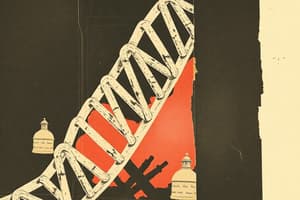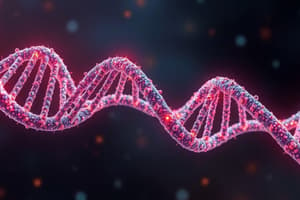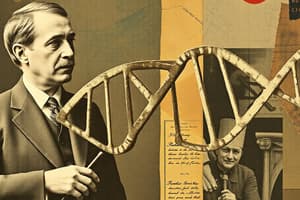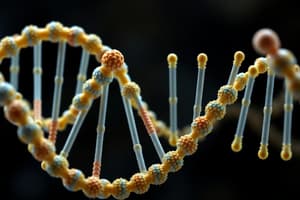Podcast
Questions and Answers
What does DNA stand for?
What does DNA stand for?
Deoxyribonucleic Acid
In what year was the existence of DNA discovered, and by whom?
In what year was the existence of DNA discovered, and by whom?
1869 by Friedrich Miescher
Who discovered the importance of DNA as a transformative factor?
Who discovered the importance of DNA as a transformative factor?
Oswald Avery
In what year was the structure of DNA finally discovered, and by whom?
In what year was the structure of DNA finally discovered, and by whom?
Whose work did Watson and Crick borrow from to conclude that DNA was in the form of a double helix?
Whose work did Watson and Crick borrow from to conclude that DNA was in the form of a double helix?
DNA can be thought of as the ______ for designing an organism.
DNA can be thought of as the ______ for designing an organism.
DNA is a large molecule (_____ ) that falls under the category of _____.
DNA is a large molecule (_____ ) that falls under the category of _____.
The monomers in nucleic acids are called _____ .
The monomers in nucleic acids are called _____ .
What are the three parts of a nucleotide?
What are the three parts of a nucleotide?
The nitrogenous bases in DNA can vary. They are either adenine, guanine, ____, or ____.
The nitrogenous bases in DNA can vary. They are either adenine, guanine, ____, or ____.
Adenine and Guanine are known as _____. Cytosine and Thymine are known as _____.
Adenine and Guanine are known as _____. Cytosine and Thymine are known as _____.
Whose work helped Watson and Crick by discovering that Adenine always binds with Thymine and that Guanine always binds with Cytosine?
Whose work helped Watson and Crick by discovering that Adenine always binds with Thymine and that Guanine always binds with Cytosine?
Adenine binds with Tymine which is written as what? Guanine binds with Cytosine which is written as what?
Adenine binds with Tymine which is written as what? Guanine binds with Cytosine which is written as what?
The bonds between the bases are _____ bonds.
The bonds between the bases are _____ bonds.
The sequence of the _____ that equal genes and thus determine the traits or characteristics in living things.
The sequence of the _____ that equal genes and thus determine the traits or characteristics in living things.
The copying of DNA happens during what?
The copying of DNA happens during what?
The DNA ______ separates the hydrogen bonds between the base pairs.
The DNA ______ separates the hydrogen bonds between the base pairs.
The enzyme _____ separates the hydrogen bonds between the base pairs.
The enzyme _____ separates the hydrogen bonds between the base pairs.
The enzyme DNA _____ grabs free-floating nucleotides and begins to pair them with the unzipped templates.
The enzyme DNA _____ grabs free-floating nucleotides and begins to pair them with the unzipped templates.
The two strands are called the _____ strand and the _____ strand.
The two strands are called the _____ strand and the _____ strand.
The leading strand builds _____ the replication fork whereas the lagging strand builds _____ from the replication fork.
The leading strand builds _____ the replication fork whereas the lagging strand builds _____ from the replication fork.
Flashcards
What does DNA stand for?
What does DNA stand for?
Deoxyribonucleic Acid. The molecule that carries genetic information in living organisms.
Who discovered DNA structure?
Who discovered DNA structure?
James Watson and Francis Crick, in 1953, based on work from Rosalind Franklin.
What type of molecule is DNA?
What type of molecule is DNA?
A large molecule (polymer) that falls under the category of nucleic acid.
What are nucleotides?
What are nucleotides?
Signup and view all the flashcards
What are the 3 parts of a nucleotide?
What are the 3 parts of a nucleotide?
Signup and view all the flashcards
What are the four nitrogenous bases in DNA?
What are the four nitrogenous bases in DNA?
Signup and view all the flashcards
What is Chargaff's rule?
What is Chargaff's rule?
Signup and view all the flashcards
What type of bond holds DNA bases together?
What type of bond holds DNA bases together?
Signup and view all the flashcards
What does Helicase do?
What does Helicase do?
Signup and view all the flashcards
What is DNA Polymerase?
What is DNA Polymerase?
Signup and view all the flashcards
Study Notes
- Chromatin forms visible chromosome structures when wound tightly
- DNA is obtained by unwinding chromatin
- DNA stands for Deoxyribonucleic Acid
History
- Friedrich Miescher discovered DNA in 1869
- DNA's role as the "transformative factor" (responsible for passing on information) was discovered in 1944
- James Watson and Francis Crick discovered DNA's double helix structure in 1953
- Watson and Crick borrowed work from scientists, especially Rosalind Franklin, to conclude DNA was in the form of a double helix
- Watson and Crick received the Nobel Prize, but Franklin was excluded because the Nobel committee doesn't give the award posthumously
- DNA serves as the blueprint for designing organisms; each individual has unique DNA
Structure Terms
- DNA is a large polymer that falls under the category of nucleic acid
- Polymers are large molecules made of monomers
- Nucleic acids, like DNA, are made of linked nucleotides
- Nucletoides have 3 parts
- Phosphate
- Deoxyribose (5-sided sugar)
- Nitrogenous base:
Nitrogenous Base Pairs
- Nitrogenous bases vary but phosphate and deoxyribose stay the same
- Nitrogenous bases
- Adenine
- Guanine
- Cytosine
- Thymine
- Adenine and Guanine are purines
- Cytosine and Thymine are pyrimidines
- Erwin Chargaff's work helped Watson and Crick
- Adenine always binds with Thymine and Guanine always binds with Cytosine
- The configuration is A-T and G-C, know as Chargaff's Rule
Bonding
- Hydrogen bonds exist between the bases
- The bases sequence determines the traits and characteristics in living things
- The sequence of bases is the key to unique genes
DNA Replication
- DNA copying occurs during interphase
- Must occur before cell division
- DNA unzips.
- Helicase, an enzyme, separates the hydrogen bonds between the base pairs
- The unzipped strands then become templates
- The enzyme DNA Polymerase grabs free-floating nucleotides and starts pairing them with the unzipped templates
- Leading and lagging strands form based on the direction of deoxyribose molecules
- The leading strand builds towards the replication fork, while the lagging strand builds away from it and is laid down in Okazaki Fragments
- The molecule separates while new strands assemble simultaneously
- In the end, two identical DNA molecules form when the entire molecule separates
Studying That Suits You
Use AI to generate personalized quizzes and flashcards to suit your learning preferences.





